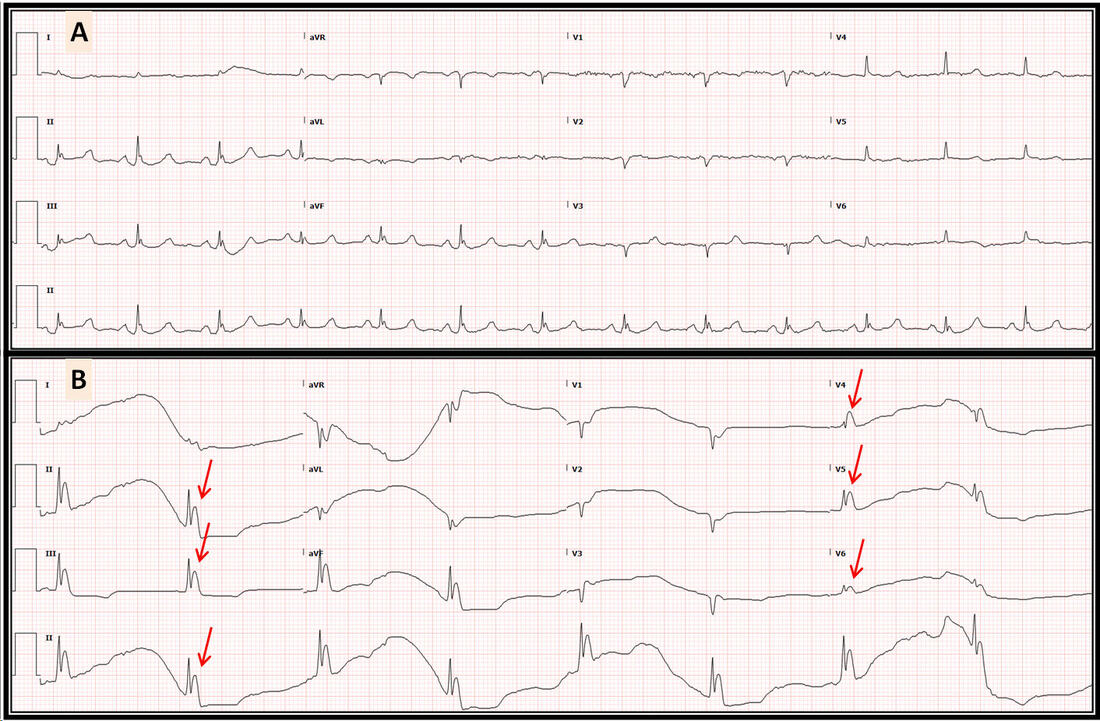July 2023 Issue
ISSN 2689-291X
ISSN 2689-291X
Monstrous Osborn Waves: A Frigid Demise!
Description
The above electrocardiogram (ECG) was obtained in an elderly patient at baseline (A) and during profound hypothermia (B) with documented severe sepsis leading to death. The prominent terminal QRS deflections consistent with Osborn (J) waves are marked with red arrows in the inferolateral leads.
Discussion
Several manifestations of hypothermia on the ECG have been described, including bradycardia and prolonged QT interval as seen in figure B above [1], in addition to prolongation of the PR interval and QRS duration. The terminal blunt deflections of the QRS complex (spike-and-dome appearance) termed Osborn waves [2] or J waves [3] are the hallmark of hypothermia on EKG. First described by John J. Osborn in 1953 [4], the mechanism of the J-wave remains unclear but appears to be related to a heterogeneous distribution of a transient outward current of the action potential [5].
References
Mustafeez Ur Rahman, M.D.
Cardiology Fellow
University of South Alabama
Mobile, AL
Mariam Riad, M.D.
Cardiology Fellow
University of South Alabama
Mobile, AL
Nupur Shah, M.D.
Cardiology Fellow
University of South Alabama
Mobile, AL
Rajasekhar Mulyala, M.D.
Cardiology Fellow
University of South Alabama
Mobile, AL
Christopher Malozzi, D.O.
Associate Professor of Cardiology
University of South Alabama
Mobile, AL
Bassam Omar, M.D., Ph.D.
Professor of Cardiology
University of South Alabama
Mobile, AL
The above electrocardiogram (ECG) was obtained in an elderly patient at baseline (A) and during profound hypothermia (B) with documented severe sepsis leading to death. The prominent terminal QRS deflections consistent with Osborn (J) waves are marked with red arrows in the inferolateral leads.
Discussion
Several manifestations of hypothermia on the ECG have been described, including bradycardia and prolonged QT interval as seen in figure B above [1], in addition to prolongation of the PR interval and QRS duration. The terminal blunt deflections of the QRS complex (spike-and-dome appearance) termed Osborn waves [2] or J waves [3] are the hallmark of hypothermia on EKG. First described by John J. Osborn in 1953 [4], the mechanism of the J-wave remains unclear but appears to be related to a heterogeneous distribution of a transient outward current of the action potential [5].
References
- Mattu A, Brady WJ, Perron AD. Electrocardiographic manifestations of hypothermia. Am J Emerg Med. 2002 Jul;20(4):314-26.
- Alhaddad IA, Khalil M, Brown EJ Jr. Osborn waves of hypothermia. Circulation. 2000 Jun 27;101(25):E233-44.
- Hudzik B, Gasior M. J-waves in hypothermia. CMAJ. 2017 Nov 27;189(47):E1461.
- OSBORN JJ. Experimental hypothermia; respiratory and blood pH changes in relation to cardiac function. Am J Physiol. 1953 Dec;175(3):389-98.
- Yan GX, Antzelevitch C. Cellular basis for the electrocardiographic J wave. Circulation. 1996 Jan 15;93(2):372-9.
Mustafeez Ur Rahman, M.D.
Cardiology Fellow
University of South Alabama
Mobile, AL
Mariam Riad, M.D.
Cardiology Fellow
University of South Alabama
Mobile, AL
Nupur Shah, M.D.
Cardiology Fellow
University of South Alabama
Mobile, AL
Rajasekhar Mulyala, M.D.
Cardiology Fellow
University of South Alabama
Mobile, AL
Christopher Malozzi, D.O.
Associate Professor of Cardiology
University of South Alabama
Mobile, AL
Bassam Omar, M.D., Ph.D.
Professor of Cardiology
University of South Alabama
Mobile, AL

